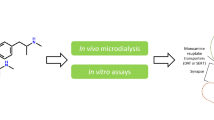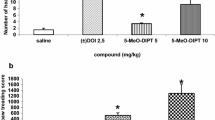Summary
Behavioural effects on dopaminergic transmission of a phenylindane derivative, Lu 19-005 [(±)-trans-3-(3,4-dichlorophenyl)-N-methyl-l-indanamine, HCl], with potent inhibitory effect on dopamine (DA), noradrenaline (NA) and serotonin (5-HT) uptake in rats and the effect on DA, NA and 5-HT activity in mice have been studied and compared with those of other known DA, NA and 5-HT uptake inhibitors with different selectivity ratios.
Lu 19-005 induced stereotyped behaviour after parenteral and oral administration with a duration of action of more than 24 h. The stereotyped licking and biting induced by Lu 19-005 was antagonized by reserpine and cis(Z)-flupentixol, but not affected by prazosin, p-chlorophenylalanine and α-methyl-p-tyrosine pretreatments. Metergoline slightly facilitated the onset of stereotypy. Lower doses of Lu 19-005 induced ipsilateral circling in unilaterally 6-hydroxy-DA-lesioned rats. Finally, Lu 19-005 antagonized the catalepsy induced by perphenazine. In mice, Lu 19-005 potentiated the apomorphine-induced gnawing, reversed tetrabenazine-induced ptosis and potentiated the behavioural effects of 5-HTP within a similar dose range.
The effects of Lu 19-005 were compared with those of other reference compounds. Nomifensine had qualitatively similar effects in rats although of much shorter duration. In mice, nomifensine selectively reversed tetrabenazine-induced ptosis. Weaker effects in all test models were found with bupropion, LR 5182 and GBR 13.069, compounds with inhibitory effect on DA and NA uptake. The DA-, NA-and 5-HT-uptake inhibitor diclofensine, however, had no effect in rats except in the 6-hydroxy-DA-circling test and had low potency in mice. The specific 5-HT-and NA-uptake inhibitors citalopram and talsupram, respectively, were ineffective in all rat models. They selectively potentiated 5-HTP or reversed tetrabenazine0induced ptosis in mice, respectively, as expected according to their in vitro profile. These results indicate that effect on DA mechanisms are responsible for the behavioural activity of the test compounds in the rat models and that the circling model is the most sensitive. Since DA may be involved in some depressive states Lu 19-005 could be an attaactive new antidepressant as it combines the pharmacological profile of established antidepressants (effect on NA and/or 5-HT uptake) with equipotent activity on DA uptake.
Similar content being viewed by others
References
Anders MW (1971) Enhancement and inhibition of drug metabolism. Ann Rev Pharm 11:37–56
Antelman SM, Chiodo LA (1981) Dopamine autoreceptor subsensitivity: A mechanism common to the treatment of depression and the induction of amphetamine psychosis? Biol Psychiatr 16:717–727
Arnt J, Christensen AV (1981) Differential reversal by scopolamine and THIP of the antistereotypic and cataleptic effects of neuroleptics. Eur J Pharmacol 69:107–111
Arnt J; Hyttel J. Fredricson Overø K (1984) Prolonged treatment with the specific 5-HT-uptake-inhibitor citalopram: Effect on dopaminergic and serotonergic functions. Pol J Pharmacol Pharm 36:217–226
Bógesø KP, Christensen AV, Hyttel J, Liljefors T (1985) 3-Phenyl-l-indanamines potential antidepressant activity and potent inhibition of dopamine, norepinephrine, and serotonin uptake. J Med Chem (in press)
Brogden RN, Heel RC, Speight TM, Avery GS (1979) Nomifensine: A review of its pharmacological properties and therapeutic efficacy in depressive illness. Drugs 18:1–24
Bræstrup C, Scheel-Krüger J (1976) Methylphenidate-like effects of the new antidepressant drug nomifensine (HOE 984). Eur J Pharmacol 38:305–312
Costall B, Kelly DM, Naylor RJ (1975) Nomifensine: A potnet dopaminergic agonist of antiparkinson potential. Psychopharmacology 41:153–164
Feighner J (1983) The new generation of antidepressants. J Clin Psychiatry 44:49–55
Ferris RM, Cooper BR, Maxwell RA (1983) Studies of bupropion's mechanism of antidepressant activity. J Clin Psychiatry 44:74–78
Heikkila RE (1981) Differential effects of several dopamine uptake inhibitors and releasing agents on locomotor activity in normal and in reserpinized mice. Life Sci 28:1867–1873
Hyttel J (1978 a) Inhibition of 3H-dopamine accumulation in rat striatal synaptosomes by psychotropic drugs. Biochem Pharmacol 27:1063–1068
Hyttel J (1978 b) Effect of a specific 5-HT uptake inhibitor, citalopram (Lu 10-171), on 3H-5-HT uptake in rat brain synaptosomes. Psychopharmacology 60:13–18
Hyttel J (1982) Citalopram — Pharmacological profile of a specific serotonin uptake inhibitor with antidepressant activity. Prog Neuropsychopharmacol Biol Psychiatry 6:277–295
Hyttel J, Larsen J-J (1985) Neurochemical profile of Lu 19-005. A potent inhibitor of uptake of dopamine, noradrenaline and serotonin. J. Neurochem (in press)
Jansen W, Brückner GW, Henauer S, Omer LMO (1982) Klinischer Doppelblindvergleich von Diclofensin und Plazebo bei geriatrischen Patienten mit depressiven Verstimmungszuständen. Pharmacopsychiatria 15:205–209
Keller HH, Schaffner R, Carruba MO, Burkard WP, Pieri M, Bonetti EP, Scherschlicht R, Da Prada M, Haefely WE (1982) Diclofensine (Ro 8-4650) — A potent inhibitor of monoamine uptake: Biochemical and behavioural effects in comparison with nomifensine. In: Costa E, Racagni G (eds) Typical and atypical antidepressants: Molecular mechanisms. Raven Press, New York, pp 249–263
Modigh K (1975) Electroconvulsive shock and postsynaptic catecholamine effects: Increased psychomotor stimulant action of apomorphine and clonidine in researpine pretreated mice by repeated ECS. J Neural Transm 36:19–32
Møller Nielsen I (1980) Tricyclic antidepressants: General pharmacology. In: Hoffmeister F, Stille G (eds) Handbook of experimental pharmacology, vol 55/I. Springer, Berlin Heidelberg New York, pp 399–414
Oberlander C, Euvrard C, Dumont D, Boissier JR (1979) Circling behaviour induced by dopamine releasers and/or uptake inhibitors during degeneration of the nigrostriatal pathway. Eur J Pharmacol 60:163–170
Randrup A, Munkvad I, Fog R, Gerlach J, Molander L, Kjellberg B, Scheel-Krüger J (1975) Mania, depression, and brain dopamine. Curr Dev Psychopharmacol 2:207–248
Rubin B, Malone MH, Waugh MH, Burke JC (1957) Bioassay of rauwolfia roots and alkaloids. J Pharmacol Exp Ther 120:125–136
Schacht U, Leven M, Gerhards HJ, Hunt P, Raynaud J-P (1982) Recent investigations on the mechanism of action of nomifensine. Int. Pharmacopsychiat (Suppl) 1, 17:21–34
Scheel-Krüger J (1970) Central effects of anticholinergic drugs measured by the apomorphine gnawing test in mice. Acta Pharmacol Toxicol 28:1–16
Scheel-Krüger J (1971) Comparative studies of various amphetamine analogues demonstrating different interactions with the metabolism of the catecholamines in the brain. Eur J Pharmacol 14:47–59
Setler P, Sarau H, McKenzie G (1976) Differential attenuation of some effects of haloperidol in rats given scopolamine. Eur J Pharmacol 39:117–126
Siegel S (1956) Nonparametric statistics for the behavioural sciences. McGraw-Hill, New York
Spyraki C, Fibiger HC (1981) Behavioural evidence for supersensitivity of postsynaptic dopamine receptors in the mesolimbic system after chronic administration of desipramine. Eur J Pharmacol 74:195–206
Sugrue MF (1981) Current concepts on the mechanisms of action of antidepressant drugs. Pharmacol Ther 13:219–247
Timsit PJ (1966) Sur l'activité cateleptigène de quelques dérivés de la butyrophénone. Therapie 21:1453–1471
Ungerstedt U (1971a) Striatal dopamine release after amphetamine or nerve degeneration revealed by rotational behaviour. Acta Physiol Scand (Suppl) 367, 82:49–68
Ungerstedt U (1971b) Postsynaptic supersensitivity after 6-hydroxydopamine induced degeneration of nigro-neostriatal dopamine system. Acta Physiol Scand (Suppl) 367, 82:69–93
Van Praag H, Korf J, Schut P (1973) Cerebral monoamines and depression. An investigation with the probenecid technique. Arch Gen Psychiatry 28:827–831
Vickroy TW, Johnson KM (1982) Similar dopamine releasing effects of phencyclidine and nonamphetamine stimulants in striatal slices. J Pharmacol Exp Ther 223:669–674
Wielosz M (1981) Increased sensitivity to dopaminergic agonists after repeated electroconvulsive shock (ECS) in rats. Neuropharmacology 20:941–945
Willner P (1983) Dopamine and depression: A review of recent evidence. III. The effects of antidepressant treatments. Brain Res Rev 6:237–246
Wong DT, Bymaster FD (1978) An inhibitor of dopamine uptake, LR 5182, cis-3-(3,4-dichlorophenyl)-2-N,N-dimethylaminomethyl-bicyclo-2,2,2-octane, hydrochloride. Life Sci 23:1041–1048
Wong DT, Bymaster FD, Reid LR (1980) Competitive inhibition of catecholamine uptake in synaptosomes of rat brain by rigid bicyclo-octanes. J Neurochem 34:1453–1458
Zee P van der, Koger HS, Gootjes J, Hespe W (1980) Aryl 1,4-dialk(en)yl-piperazines as selective and very potent inhibitors of dopamine uptake. Eur J Med Chem 15:363–370
Author information
Authors and Affiliations
Rights and permissions
About this article
Cite this article
Arnt, J., Christensen, A.V. & Hyttel, J. Pharmacology in vivo of the phenylindan derivative, lu 19-005, a new potent inhibitor of dopamine, noradrenaline and 5-hydroxytryptamine uptake in rat brain. Naunyn-Schmiedeberg's Arch. Pharmacol. 329, 101–107 (1985). https://doi.org/10.1007/BF00501197
Received:
Accepted:
Issue Date:
DOI: https://doi.org/10.1007/BF00501197




